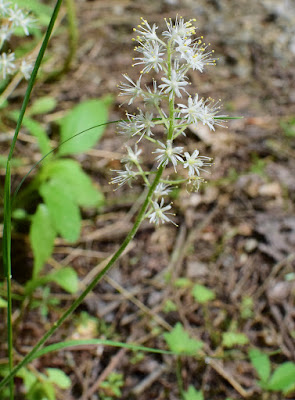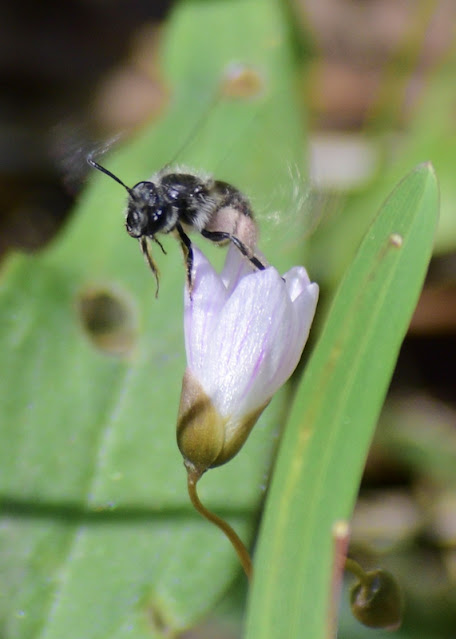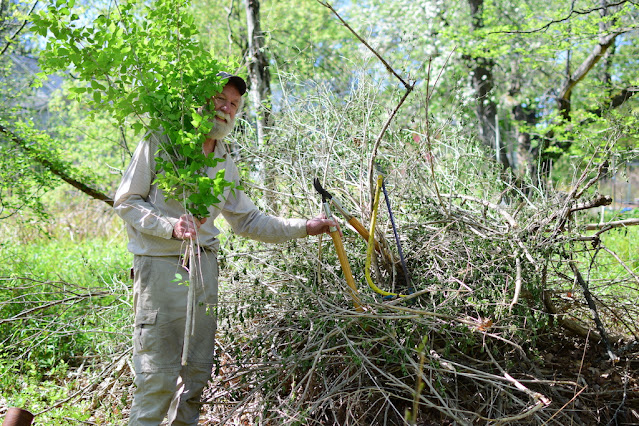Save Earth. Rescue Nature. Protect native flora and fauna - the habitat that each species requires for life. Introduction
What can we do as individual landowners (small to large)? There may be many answers, though as Dr. Douglas Tallamy states, “We may be nature’s last hope”. Maeve and I continually explore what is in our capacity to do, and work, sometimes creatively, to make it happen on our one-acre lot in Jericho, Vermont.
Like many others, we want a diverse and greater population of pollinators, and other beneficial insects, birds, amphibians, and other wildlife.
Therefore we set out, three years ago, to build a backyard nature sanctuary for wildlife, and for ourselves.
2021 update, here are some of our spring 2021 plantings
Also, (2) Thalictrum dioicum (Early Meadow Rue), (1) Thalictrum pubescens (Tall Meadow Rue), (1) Veronicastrum virginicum (Culvers Root), (1) Clematis virgiania, (1)Asclepias Incarnata (Swamp milkweed). (Raffle prize).
Also planted 3 bare root Redbud trees and a Carolina Spicebush, sourced from Michigan Bulb Co.
Wintergreen. They like acidic soil and shade to part shade.
Pussy willow stems harvested locally for planting.
A recent study in biodiversity states "Consequently, functional diversity metrics incorporating functional traits and species abundance provide an indirect way to measure resilience and integrity (Standish et al., 2014), and are increasingly used in large‐scale assessments of North American bird and ecological communities (Schipper et al., 2016; Schleuter et al., 2010). Metrics for Conservation Success...
We believe the process of building a backyard nature sanctuary begins and ends with amending and otherwise helping to improve the health of the soil; while at the same time planting native shrubs, native trees, native grasses, and native wildflowers to give greater balance against the onslaught of non-native plants that in general are of no or little benefit to our native wildlife. Combatting if not eradicating invasive plants from our property is another thread of our patchwork effort to improve the habitat that we can directly influence. Read about invasive ID and management on the Vermont Invasives webpage.
"What we contemplate here is more than ecological restoration; it is the restoration of relationship between plants and people. Scientists have made a dent in understanding how to put ecosystems back together, but our experiments focus on soil pH and hydrology-matter, to the exclusion of spirit. We are dreaming of a time when the land might give thanks for the people." Robin Wall Kimmerer in Braiding Sweetgrass.
Let us ensure the Biodiversity of all Life. All Life Matters. ~Bernie
Building Soil Health - soil structure and soil microbes - by minimizing soil disturbance, while maximizing soil cover and biodiversity.
1. No-till or at least greatly reduce tillage. Tillage can wipe out all gains from the actions listed below.
2. Keep soil covered with residue (holds moisture in the soil, provides organic matter for soil microbes).
3. Keep *living roots in the soil as many months of the year as you can (feeds microbes-maintains living soil, builds soil structure). *Living roots, help water and nutrient infiltration. Deep roots help water and nutrient infiltration to go deeper into the soil.
4. Diverse native plantings including cover crops - supports beneficial insect species and soil microbes.
5. Livestock - speeds up increased diversity, feeding the soil microbes, improving soil health.
This series of upcoming postings will describe our efforts, some with success stories, some with failures, and many that we will be measuring each year to determine if we are indeed meeting our goals.
Are we experts in any of these areas? By no means. We aim to share with you what we have done, experimented with, experienced, observed, and hopefully give you a sense of the pleasure we obtain every day from collaborating with nature and just being outdoors. My motto is Stop, Look, and Listen. From close and frequent observations, nature will often please you if not occasionally astound you. We recommend “Step outdoors as often as you can and give her a try”.
Some common themes throughout are:
We try to work with nature using her examples and her locally sourced raw materials.
We accept that like trees, we are in this for the long game and try to be patient in accepting growth measured in years.
Nature is resilient, but she also has some pretty firm rules and behaviors regardless of how we think processes should work and how we think landscapes should look like.
Topics we will address include:
Raw Products. Finding, acquiring, and then incorporating raw products to improve the soil in our yard including a novel theory I have about growing trees from cardboard, and how to build a ski slope in your yard without a permit. All the while, having fun and learning about living organisms (beyond human life).
Humor. Some of the topics, like the first one about cardboard, will incorporate my sense of humor through storytelling.
Community. In each of our segments, we are likely to mention the support we get from our neighbors throughout our small town and the towns nearby in terms of providing much of the raw materials we utilize. We are indeed grateful for our Vermont community.
Observing life in our backyard. This year (2020), I made a concerted effort to observe and record the insects on our property from spring through summer. By comparing the results each year we hope to measure whether the biodiversity and quantity of pollinators and other beneficial insects changes as our native plantings (improved habitat) become more established.
Native Plants. Choosing, purchasing (where to purchase), and growing locally sourced native plants. Identifying which plants are native to Vermont, or at least native to the North-eastern United States.
Growing wildflowers from seed. Where to purchase native seed, how to prepare a plot, how to plant wildflower seeds.
Learning, and being inspired by others with similar missions - neighbors, local farmers, homesteaders, those who write books with gleams of insight from science and tested methods.
Invasives. Fighting a war of many battles with invasive plants of which we have about a half dozen, one or two of which are particularly good at blocking native plants from growing and are particularly difficult to diminish never mind eradicate.
Growing blueberries of gold when you have clay soil.
Growing fruit and vegetables and the beneficial insects including pollinators that we need as collaborators, and that we enjoy viewing.
Building raised beds from locally grown and sourced wood. Building hugelkultur mounds (pronounced Hoo-gul-culture). - think very high raised bed built incorporating logs, sticks, branches, leaves, grass cuttings, unwanted scrap cotton clothing, food scraps from the compost pile, composted used coffee grounds, and other materials.
The funny thing(s) that happened on the way to creating our Eden.
Chipmunks - one of nature’s adorable creatures until they come for dinner and never go home.
Birds. Sit and watch, there is more to see in your own backyard than you might have thought or so we found out thanks in part to Covid. Why we grow plants for caterpillars - for baby birds, beautiful moths, and butterflies.
Critter houses and brush/woodpiles, shallow watering stations, - both man-made and nature-made - for native bees, bumblebees, frogs, toads, butterflies, and other critters.
Mowing reduction. We only mow paths - similar to trails in the forest. Removing the shackles of lawn care for a more natural pleasing look, greater diversity of plants and animals, and more free time for us.
Water in a climate-changing world - too much, too little, how we are preparing for summer weather extremes.
Composting food scraps and composting leaves. We like simple, no-fuss methods.
Are we brave enough to raise chickens? (It must be easier than raising kids, right?)
We will discuss the resource materials we have put together. I created a list of plants that are native to Vermont, noting relationships between individual native plants and the pollinators and other insect species. We also maintain a blog about birds and birding (VT Birds and Words). I frequently post pollinator and related plant information on this Jericho Vermont blog.
Beyond the backyard - adding native diversity and color to our greenbelts (area between the roadway and the sidewalk).
Over this winter and next spring and summer, we will map the entire yard on a spreadsheet with each cell representing and naming a plant in the yard.
Conservation can happen in your own yard. I hope you enjoy learning about our adventures in building a backyard nature sanctuary for insects, pollinators, birds, and other wildlife - as well as for our own well-being.
Bernie and Maeve
We will be outside until it is time to hibernate and to write upcoming posts about the aforementioned topics. We hope you make plans to build a wildlife habitat in your backyard. Perhaps you might share the lessons and results with us.
Recommended viewing:
Gardening For Life: What we can do (in our backyards) about wildlife losses. For a brief overview of the wildlife losses since 1970 and what we can do about it, read this two-page article by Prof. Douglas Tallamy.
https://homegrownnationalpark.com/tallamy/not-in-our-yard-doug-tallamy
Farming for the future. (Improving soil at home as well as on farms). Gabe Brown delivers the keynote address “Regenerative Agriculture – Letting Nature Work For You” at Farming For The Future 2020 in Lawrence, MI.
https://www.youtube.com/watch?v=ExXwGkJ1oGI
Composting:
https://www.tenthacrefarm.com/building-the-right-compost-bin/?utm_source=ml&utm_medium=email&utm_campaign=6_ways_to_build_a_compost_system&utm_term=
iNaturalist: To view my observation postings on iNaturalist
https://www.inaturalist.org/observations?user_id=bepaquet
iNaturalist - what is being seen, what we hope to find, how you can help, learn, and find greater enjoyment in what you observe and record of life in nature. As well as to see what others are observing. I observed and recorded over 350 species of insects in our yard this year (2020). How many forms of life will you discover in your backyard?


























































